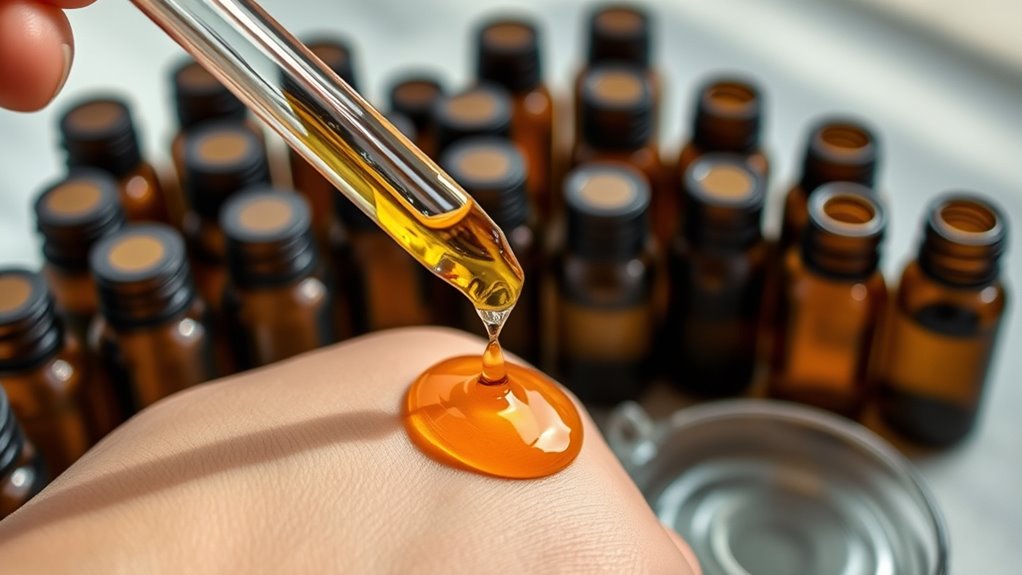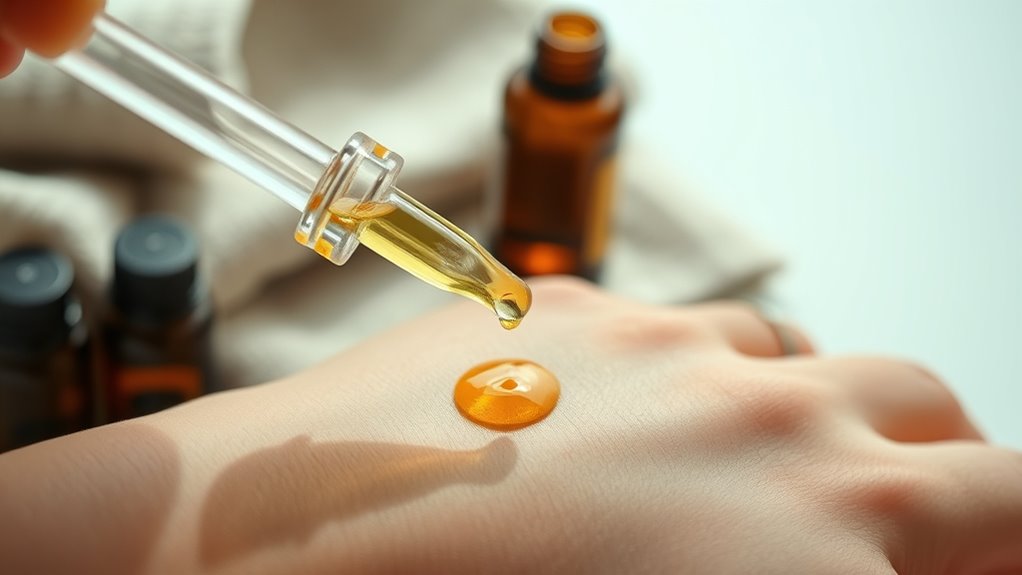To safely use essential oils on your skin, always dilute them with a carrier oil like coconut or jojoba. For face and sensitive areas, aim for a 1-2% dilution (about 1-2 drops per teaspoon). For arms or legs, you can increase to 3-5%. Always do a patch test first and store your blends in a cool, dark place. If you’re ready to learn simple tips for safe application, keep exploring.
Key Takeaways
- Always dilute essential oils with a carrier oil (1-2 drops per teaspoon) for face and sensitive areas to prevent irritation.
- Conduct a patch test by applying diluted oil to a small skin area and wait 24 hours for reactions.
- Use appropriate dilution ratios based on application area: 1-2% for face, 3-5% for arms or legs.
- Store diluted oils in a cool, dark place to maintain quality and reduce the risk of skin reactions.
- Use clean applicators and avoid over-application to minimize irritation and ensure safe, effective use.

Using essential oils on your skin can enhance your natural glow and provide targeted relief, but it’s important to understand how to do so safely. One of the biggest mistakes people make is applying oils directly without proper dilution. Essential oils are highly concentrated and can cause skin irritation, burns, or allergic reactions if used undiluted. To avoid this, always dilute your essential oils with a carrier oil before applying them to your skin. Common carrier oils include coconut, jojoba, almond, or grapeseed oil. A good rule of thumb is to use a dilution ratio of about 1-2% for the face and sensitive areas, which translates to roughly 1-2 drops of essential oil per teaspoon of carrier oil. For more resilient skin on your arms or legs, you might go up to 3-5%.
When diluting, measure carefully to ensure safety and effectiveness. Using a small glass bottle with a dropper makes it easier to control the number of drops you add. Before applying the mixture widely, do a patch test to check for any adverse reactions. Apply a small amount of the diluted oil to your inner wrist or behind your ear, and wait 24 hours to see if any redness, itching, or irritation develops. If irritation occurs, wash the area with soap and water, and avoid using that particular oil again or reduce the concentration in future applications.
Additionally, it’s helpful to be aware of skin sensitivities and how certain oils may react differently depending on individual skin types. Store your diluted oils in a cool, dark place to preserve their potency and prevent spoilage. Proper storage also minimizes risk of skin reactions caused by oxidized or degraded oils. When applying, use clean hands or a sterile applicator to avoid introducing bacteria or dirt into the mixture. Be mindful of the amount you use; a little goes a long way, and excess oil can increase the chance of irritation.
Frequently Asked Questions
Can Children Safely Use Essential Oils on Their Skin?
Yes, children can safely use essential oils on their skin when you dilute them properly. Always choose gentle oils like lavender or chamomile and use a much lower dilution ratio than for adults. Test a small patch first to check for reactions, and avoid applying oils near the eyes or sensitive areas. Consult a healthcare professional if you’re unsure, and never give essential oils to infants without expert guidance.
Are There Specific Oils That Should Never Be Diluted?
No, there aren’t specific oils that should never be diluted. Instead, always research each oil’s safety guidelines before applying them to your skin. Some oils, like cinnamon or clove, are potent and require more careful dilution, while others, like lavender or chamomile, are gentler. Always follow recommended dilution ratios and do a patch test to avoid skin reactions, ensuring safe and effective use of essential oils.
How Does Skin Type Affect Essential Oil Dilution?
Did you know that sensitive skin affects about 15% of the population? Your skin type plays a big role in how much you should dilute essential oils. If you have sensitive or dry skin, use a higher dilution ratio to prevent irritation. Oily or thicker skin can usually handle more concentrated oils. Always patch test and adjust dilution based on how your skin reacts to keep your skin safe and healthy.
Can Essential Oils Cause Allergic Reactions Even When Diluted?
Yes, essential oils can cause allergic reactions even when diluted. You might experience redness, itching, or irritation if you’re sensitive or allergic to a specific oil. Always do a patch test before wider use, even with diluted oils. If you notice any adverse reactions, wash the area immediately and discontinue use. Consulting a healthcare professional is wise if reactions persist or worsen.
How Long Should I Wait After Applying Diluted Oils Before Sun Exposure?
You should wait at least 12 hours after applying diluted essential oils before exposing your skin to the sun. This time allows your skin to absorb the oils fully, reducing the risk of photosensitivity, burns, or irritation. Whether you’re heading outdoors or expecting prolonged sun exposure, giving your skin this pause helps protect it. Always perform a patch test first and follow specific oil guidelines to stay safe.
Conclusion
Remember, diluting your essential oils is like watering a garden—without it, things can get overwhelmed or burned. By following proper dilution guidelines, you’re gently guiding these potent drops to nurture your skin safely. Think of it as a delicate dance, where each step ensures harmony and health. When in doubt, always err on the side of caution; it’s your skin’s best shield against irritation and harm.









